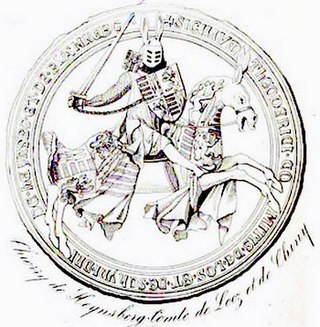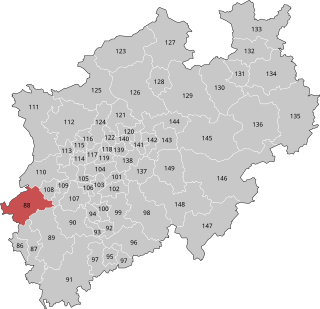Henry I, Lord of Heinsberg (died 1259) was a German nobleman. He was the second son of Gottfried III, Count of Sponheim and ruled as lord of Heinsberg from 1228 until his death.
Henry I, Lord of Heinsberg (died 1259) was a German nobleman. He was the second son of Gottfried III, Count of Sponheim and ruled as lord of Heinsberg from 1228 until his death.
Heinsberg is a Kreis (district) in the west of North Rhine-Westphalia, Germany with the town of Heinsberg as its capital. Neighbouring districts are Viersen, Neuss, Düren and Aachen, the city of Mönchengladbach and the Dutch province Limburg.

Heinsberg is a town in North Rhine-Westphalia, Germany. It is the seat of the district Heinsberg. It is situated near the border with the Netherlands, on the river Wurm, approx. 20 km north-east of Sittard and 30 km south-west of Mönchengladbach.

The County of Loon was a county in the Holy Roman Empire, which corresponded approximately with the modern Belgian province of Limburg. It was named after the original seat of its count, Loon, which is today called Borgloon. During the middle ages the counts moved their court to a more central position in Kuringen, which today forms part of Hasselt, capital of the province.

Operation Blackcock was an operation to clear German troops from the Roer Triangle, formed by the towns of Roermond and Sittard in the Netherlands and Heinsberg in Germany during the fighting on the Western Front in the Second World War. It was conducted by the British Second Army between 13 and 26 January 1945. The objective was to drive the German 15th Army back across the rivers Roer and Wurm and move the frontline further into Germany. The operation was carried out by Lieutenant-General Neil Ritchie's XII Corps by three divisions: the 7th Armoured Division, the 43rd (Wessex) Infantry Division and the 52nd (Lowland) Infantry Division. The operation, named after the Scottish male black grouse, is relatively unknown.

Waldfeucht is a German municipality in the Heinsberg district, in North Rhine-Westphalia, Federal Republic of Germany. It is situated on the border with the Kingdom of the Netherlands, approx. 15 km south of Roermond and 8 km west of Heinsberg.
Philip I was Archbishop of Cologne and Archchancellor of Italy from 1167 to 1191.
Adolf, Duke of Jülich-Berg, was the first Duke of the combined duchies of Jülich and Berg. He was the son of William II of Berg and Anna of the Palatinate.

Lady Mary of Looz-Heinsberg, Dutch: Maria van Loon-Heinsberg, was a noble lady from the House of Looz and through marriage Countess of Nassau-Siegen.
John III of Nassau-Weilburg was count of Nassau-Weilburg as co-regent with his father. He came from the Walramian branch of the House of Nassau.

The Rhine-Niers-Bahn is a Regionalbahn service in the German state of North Rhine-Westphalia. It connects Essen Hbf, Duisburg Hbf on the Rhine with Mönchengladbach on the Niers, Aachen and Heinsberg.
Dremmen is a former municipality in the district of Heinsberg, North Rhine-Westphalia, Germany. It has been part of the district town of Heinsberg since 1972. It includes the main village Dremmen and the villages Herb and Boverath.

Diederik of Heinsberg was the Count of Loon and Count of Chiny (1336–1361).
Godfrey de Heinsberg, Lord of Daelenbroeck, Count of Looz and Count of Chiny (1361–1362), son of John of Heinsberg, Lord of Daelenbroeck.

John II of Loon, Lord of Jülich, Heinsberg and Löwenberg, son of Godfrey de Heinsberg, Count of Looz, and Philippa of Jülich, daughter of William V, Duke of Jülich, and Joanna of Hainaut. Although John was the first son of Godfrey, he did not inherit the countship of Looz, the title instead going to Arnold of Rumingy.
Gottfried III, Count of Sponheim was a German nobleman. He succeeded his father Gottfried II as Count of Sponheim.
The Lordship of Heinsberg was a territory within the Holy Roman Empire, centred on the city of Heinsberg. The most notable member of the house of Heinsberg was Philip I, archbishop and archchancellor.

Heinsberg (Rheinland) station is a terminus in Heinsberg in the German state of North Rhine-Westphalia and is at the end of the Lindern–Heinsberg railway. The entrance building and the freight sheds were successively demolished in 1997 after the closure of the passenger service in 1980, the end of freight traffic to Heinsberg in 1994 and the closure of the line between Oberbruch and Heinsberg in 1997. In preparation for the reactivation of passenger services on 15 December 2013, a new island platform was erected to the east of the site of the demolished entrance building.
This article outlines the COVID-19 pandemic in the German federal state of North Rhine-Westphalia. As of April, there have been 19,384 confirmed cases, including 446 deaths.

Wilfried Oellers is a German lawyer and politician of the Christian Democratic Union (CDU) who has been serving as a member of the Bundestag from the state of North Rhine-Westphalia since 2013.

Heinsberg is an electoral constituency represented in the Bundestag. It elects one member via first-past-the-post voting. Under the current constituency numbering system, it is designated as constituency 88. It is located in western North Rhine-Westphalia, comprising the Heinsberg district.